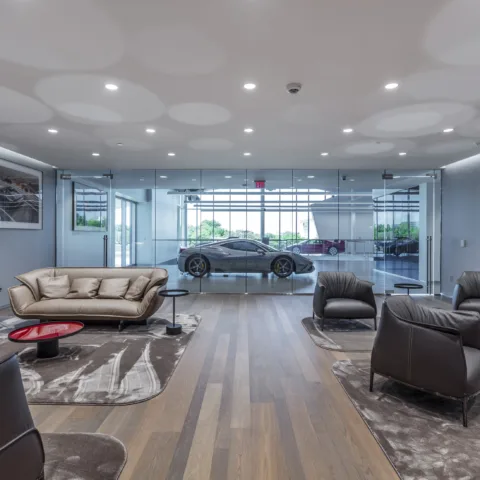Sustainability has become an increasingly important and popular topic in commercial construction, especially in urban development. It comes up in nearly every new project conversation we have as a general contractor. We consistently hear from owners and developers who are looking for ways to reduce waste and lessen their environmental impact.
As we collaborate with clients about how they can reduce costs and take an environmentally friendly approach, here are a few common principles we share to explain sustainable construction.
4 Elements of a Sustainable Construction Project
Here are four ways Crain works to make an impact by embracing a sustainable construction approach:
1. Incorporate sustainability into the building design and pre-construction process.
The first opportunity to incorporate sustainability comes in the building design phase. Architecture and engineering firms play a significant role in sustainable design. But our pre-construction team also supports this effort by setting a project up for success before it begins.
Another thing we consider is finding ways to extend a building’s lifespan. The longer a building can be used, the longer a client can avoid demolition, cleanup, and rebuilding.
2. Optimize the Job Site Potential
Sustainable construction also involves a thoughtful approach to how we work the site. This means taking the location, landscape, orientation, and the possibility of reusing existing buildings into consideration. Taking the time to optimize each job site is a valuable way to eliminate the negative impact on local ecosystems, infrastructure, and energy systems.
3. Manage and Reduce Construction Waste
According to Construction & Demolition Recycling, the volume of construction waste generated each year is expected to double to 2.2 billion tons by 2025. Sustainable construction gives contractors an opportunity to reduce that number by boosting efforts to reuse and recycle as much waste material as possible. For instance, concrete and steel have plenty of useful life in them after demolition and can be used for foundations or as aggregate beneath parking lots.
4. Use Prefabricated or Sustainable Materials
This has become an increasingly popular area of emphasis as architects and clients seeking certifications such as LEED (Leadership in Energy and Environmental Design) and WELL (WELL Building Standard) are incentivized to select materials manufactured from recycled products and from local sources. Prefabricated construction materials and methods are also highly sustainable. In fact, it takes up to 67 percent less energy to manufacture a prefab building than it does to build a conventional structure, according to Clearview Modular Buildings. Using prefabricated and sustainable materials is something our team is committed to pursuing as it makes sense for the overall goals of our clients.
A Few of Crain’s Sustainable Construction Projects
Intentionality and sustainability are at the heart of everything we do at Crain. These values influence the way we approach projects and the way we conduct business — because we care about more than simply completing a project. We build with our client’s long-term interests in mind. We are also mindful of how a project impacts the surrounding area. We want to add value to the landscape as a whole, whether that’s in our hometown of Nashville or another project in a surrounding area.
To that end, our team works to create a long-term strategy that considers sustainability in every process from start to finish. Here are a few recent projects in which we were able to incorporate some creative and effective sustainable construction ideas:
- Element Hotel — This project enabled our team at Crain to incorporate sustainability into the building design and pre-construction process. As a LEED-certified hotel in Nashville, our pre-construction team worked to provide design/build MEP services in order to strategically complete this project in an urban setting. The hotel uses five floors of prefabricated stick framing on a concrete podium that bears on caissons. Anticipating price increases, Crain Construction purchased wood early, saving the client thousands of dollars.
- Belle Meade Towncenter — Through adaptive reuse, this old movie theater was converted into an urban grocery store. A portion of the site was donated and is now a public street connector with pedestrian amenities and parallel parking.
- Acme Feed & Seed Restaurant and Music Venue — Serving as a cornerstone of Broadway in downtown Nashville, our team worked diligently to meet current codes and National Historic Register requirements. We were honored to receive an Excellence in Construction Award for the adaptive reuse in this project.
- Turnip Truck West Nashville — Turnip Truck takes an environmentally friendly approach to everything they do. As part of renovating a building for their location in West Nashville, our team installed solar panels on a complex area of their roof. These panels now provide 15 percent of the store’s energy.
- Lipscomb University Pharmaceutical Sciences Research Center— This project provided an opportunity for us to manage and reduce construction waste. As a LEED project, we worked closely with the team at Lipscomb to emphasize construction waste recycling throughout the project.
Discover a More Sustainable Approach for Your Next Project
With almost 90 years of diverse commercial construction experience ranging from adaptive reuse to ground-up luxury hotels, our team at Crain has successfully completed numerous sustainable projects. If you’d like to find out how to incorporate a more sustainable approach into your project, we’d love to talk. Our team can show you how to create a sustainable commercial building to fit your project’s specific needs.



